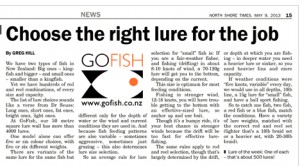Choose the right lure for the job.
- Posted on
- By Greg Hill

We have two types of fish in New Zealand: big ones (kingfish and bigger) and small ones (smaller than a kingfish). Yet we have hundreds of rod and reel combinations, of every size and capacity. The list of lure choices sounds like a verse from Dr Seuss: long ones, short ones, fat ones, bright ones, light ones.
We have two types of fish in New Zealand: big ones (kingfish and bigger) and small ones (smaller than a kingfish). Yet we have hundreds of rod and reel combinations, of every size and capacity. The list of lure choices sounds like a verse from Dr Seuss: long ones, short ones, fat ones, bright ones, light ones.
At GoFish, our 30m2 lure wall has more than 4000 lures. One model alone can offer 5 or 6 colour choices, with 5-6 different weights. There are variants of the same lure for the same fish, but different only for the depth of water or the wind and current conditions they are used in. And, because fish feeding patterns are also variable – sometimes aggressive, sometimes just grazing – this also determines lure size selection.
So, an average rule for lure selection for “small” fish is: if you are a fair-weather fisher, and fishing (drifting) in about 8-10 knots of wind, a 70-120g lure will get you to the bottom, depending on the current. This size is optimum for most feeding conditions.
Fishing in stronger wind, 12-18 knots, you will have trouble getting to the bottom with an effective-sized lure, so anchor up and use bait. Though it’s a bumpy ride, it’s your best chance in stronger winds because the drift will be too fast for effective lure-fishing.
The same rules apply to rod and reel selection, though that’s largely determined by the drift, or depth at which you are fishing – in deeper water you need a heavier lure or sinker, so you need heavier line and more capacity.
If weather conditions were “five knots, variable” every day, we would use in all depths, 10lb line, a 15g lure for “small” fish, and have a ball, sport fishing..
So to catch one fish, two fish, a red fish or a blue fish, match the conditions. Have a variety of lure weights, matched with the correct rod and reel set (lighter that’s a 10lb braid set or a heavier set, with 20-30lb braid).

